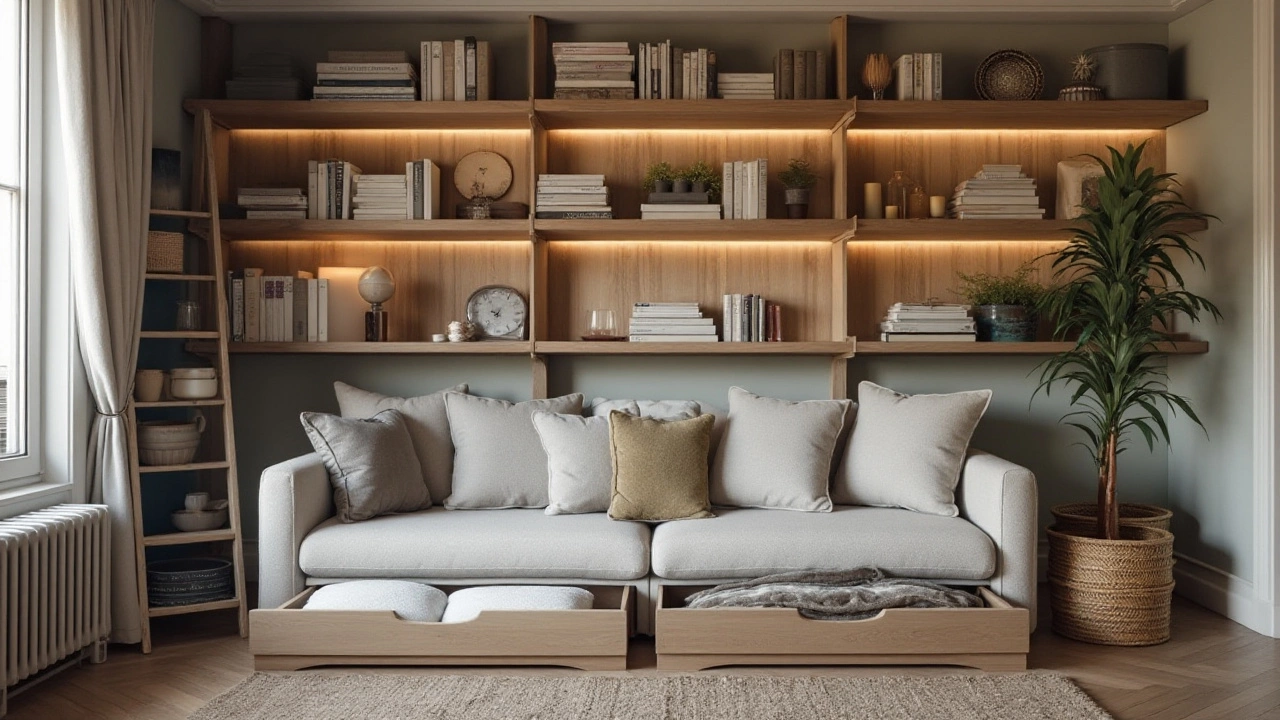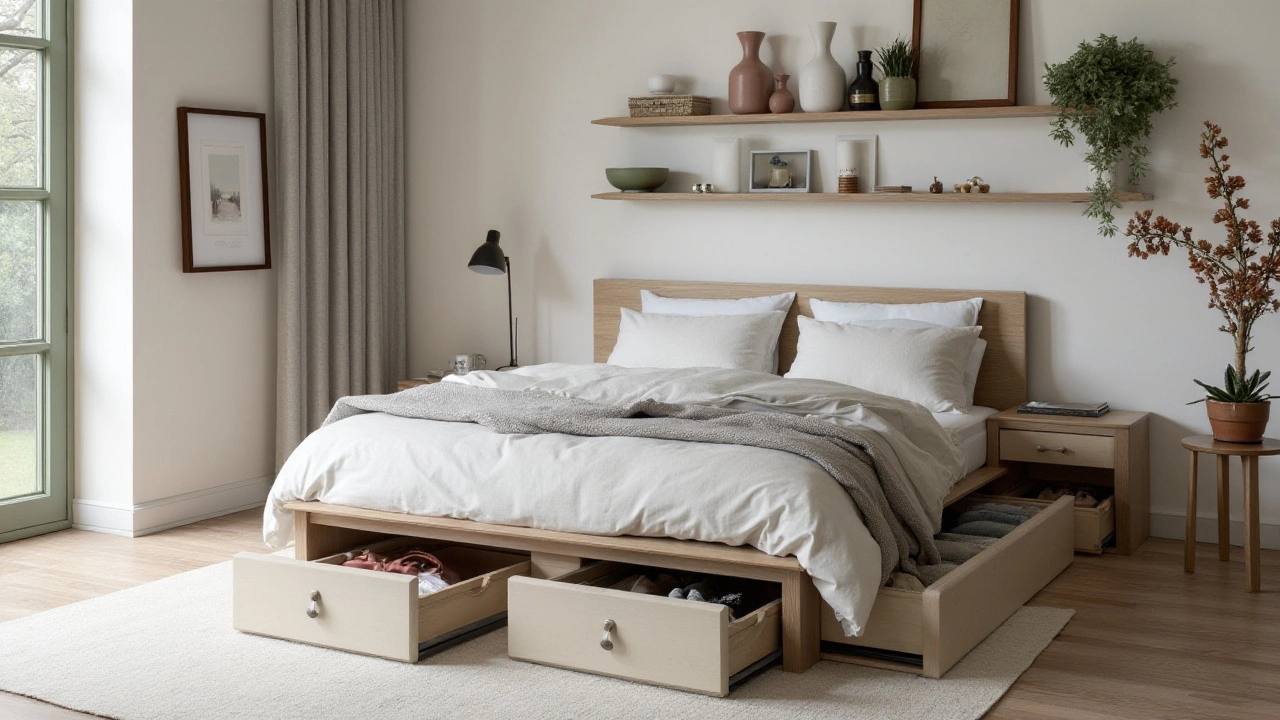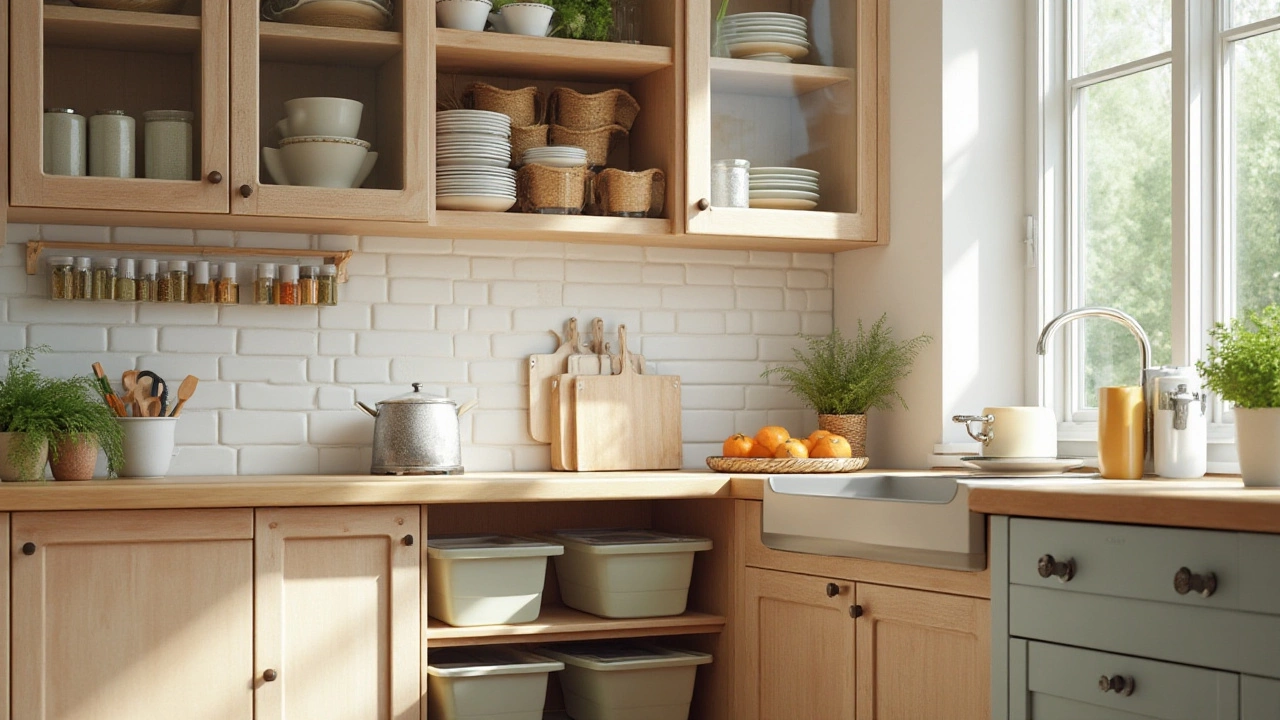Creative Storage Ideas for Small Spaces: When There's No Room Left
 Dec, 25 2024
Dec, 25 2024
Finding yourself surrounded by clutter can be overwhelming, especially when every nook and cranny of your living space is filled. Whether you live in a compact apartment or an older home that lacks built-in storage, tackling the dilemma of finding places for your existing and new treasures is important. The good news is that being creative with your storage solutions can make a world of difference.
In today's fast-paced life, where acquiring new items often seems easier than letting go of the old ones, strategic thinking about space can lead to surprisingly effective results. From thinking vertically to utilizing unexpected spaces, this read offers down-to-earth advice for reclaiming your home from the clutches of chaos. Immerse yourself in solutions that aren't just practical, but also stylish and adaptable to your personal needs.
Join me in exploring smart techniques that will seamlessly declutter your environment, because in the end, a little creativity goes a long way in turning tight quarters into efficient, comfortable living spaces.
- Understanding Your Space
- Decluttering Essentials
- Innovative Storage Solutions
- Maximizing Vertical Areas
- Hidden Storage Ideas
- Personalized Organizational Tips
Understanding Your Space
Before diving into the world of storage solutions, it's vital to take a moment to truly understand the space you have. It's more than just measuring dimensions; it's about recognizing the potential each area holds. Start by going around each room and identifying the spots that are underutilized. Common areas include corners, walls, and spaces under furniture. Uncover these overlooked spots and realize how they can accommodate more than you ever imagined.
Creating a mental map of your home as a series of zones rather than individual rooms can help in finding fresh opportunities for storage. Consider vertical spaces that often go unnoticed due to our horizontal living habits. Implementing wall-mounted shelves or hooks can instantly add storage capacity without using up precious floor area. Take into account the functionality and daily use of each space, ensuring that any solutions applied complement the room's purpose and your lifestyle.
As Ricky Gonzalez, a renowned interior designer, puts it,
"Optimizing your space is not about adding more to it, but about understanding the value of absence and making every piece earn its place." This philosophy guides the transformation of small spaces into well-organized habitats. When thinking about decluttering, remember that it's not always about throwing things away; often, it's about smarter storage that keeps your essentials within reach and your home looking great.
In a study conducted by the National Association of Professional Organizers, 54% of Americans feel overwhelmed with their clutter and 78% of them report a boost in happiness when they declutter and reorganize their living spaces. This emotional uplift is often mirrored by the newfound utility of their living quarters. Assessing your space with a critical eye and an open mind can thus be the first essential step towards a calmer and more productive environment.
If your small space is part of a shared home, consider how to individually customize storage solutions in communal areas while maintaining a sense of unity and style. It's a balancing act that, with creativity and understanding of the dynamics at play, results in a cohesive yet personal shared environment. Never underestimate the power of a well-organized home; it offers peace of mind and a stronger, refreshed outlook on daily life.
Decluttering Essentials
Decluttering is more than just tidying up; it's about creating a space that breathes easier and fosters a sense of calm in your home. It's about assessing each item's place and purpose, and making thoughtful decisions about what stays and what goes. One practical approach to start the decluttering process is by applying the KonMari Method, which encourages keeping items that truly bring you joy. Marie Kondo, the founder of this method, suggests holding each item in your hands and asking yourself if it sparks joy. If it doesn't, it's time to let it go. This technique pushes us to focus on the sentimentality and utility of our belongings rather than sheer abundance.
To kick off your decluttering journey, consider categorizing your items instead of tackling clutter room by room. Begin with clothes, move to books, papers, miscellaneous items, and finish with sentimental treasures. By sorting in this manner, you build a momentum where mastering categories prepares you for more challenging decisions later. Embrace the principle of one in, one out: for every new item you bring in, commit to removing another. This aids in maintaining balance and ensures that your space remains uncluttered. Additionally, adopting a system to handle miscellaneous paper clutter—such as mail, receipts, and notes—can vastly improve organizational flow at home.
"Tidying is a special event. Don't do it every day. Once you have made your house into your ideal home, the scope of what you need to do will be limited to the extremely simple task of putting things back where they belong." — Marie Kondo
Another key to successful decluttering is to make the process a family affair. Engage your loved ones by setting common goals and making it a fun activity. For instance, assign roles to each family member and chart their progress while rewarding achievements. This not only helps distribute the workload but also cultivates a shared commitment to maintaining a tidy home. It's also vital to implement regular reviews—monthly or quarterly check-ins to reassess your possessions and ensure clutter doesn't make its way back into your life.
For those who find themselves buried under mountains of keepsakes and rarely used items, consider more radical approaches. A successful strategy is setting up stations: a donation box, a sell/consign box, a recycle box, and a trash bin. These stations make it simpler to make quick decisions and keep the process moving smoothly. As you sift through your belongings, remember: sentimental items don't have to be physical. Often, photographing items can allow you to retain a memory without the physical baggage.
Finally, don't defer decisions with a 'just-in-case' mentality, which often leads to keeping unnecessary objects. Lean into the power of discovering what you truly need and make sure you only keep those storage solutions that truly matter. With patience and dedication, decluttering can renew your space, giving it functionality and peace—a place where every item has a designated home. Start today and feel the transformational power of a clutter-free abode, making room for a more intentional, serene lifestyle.

Innovative Storage Solutions
In an age where every inch of living space counts, coming up with innovative storage solutions can make a significant difference. The need for clever organizing ideas often gives rise to remarkable inventions that transform the way we think about space utilization. One ingenious idea is utilizing underutilized furniture. Take, for example, the versatile daybed, which not only offers seating and a sleeping area but can also have built-in drawers or a trundle bed beneath it for storage. This not only improves storage capacity but also keeps items conveniently accessible. Kitchen areas are often under scrutiny, with spice racks on cabinet doors and toe-kick drawers beneath lower cabinets maximizing unused space. These developments are reflections of how we can effectively multi-purpose items that are often overlooked in day-to-day living.
Consider installing wall-mounted desks that can be folded away when not in use or investing in furniture pieces that come with hidden compartments. Coffee tables with lifting tops can provide a place to stow remote controls, magazines, or games out of sight but within easy reach. Innovation is also embracing technology with smart storage solutions that integrate charging ports within drawers or track the contents in your pantry digitally. In this context, the words of Marie Kondo resonate, "The best way to find out what we really need is to get rid of what we don’t."
When you truly cherish each item, finding a place for them becomes less of a clutter challenge and more an act of love.These alternative perspectives don't just solve storage issues but make it a thoughtful journey towards a more curated, mindful living space.
Notably, now we see developments in modular shelving systems which you can customize to fit any corner or awkward space. These systems are fantastic, especially in small apartments, where personal touches in design and functionality can turn limitations into opportunities. Bedrooms often benefit from under-bed storage solutions, and there are multiple styles, such as pull-out drawers or containers equipped with wheels, perfect for seasonal clothing. Additionally, floating shelves can adorn almost any room, serving both a decorative and practical function. Another significant yet unnoticed spot could be the ceiling; think hanging pot racks in kitchens or bike hooks for garages. As of 2023, surveys have shown that 78% of homeowners in urban areas are actively looking for space-saving techniques to enhance lifestyle quality, indicating a growing trend towards maximizing minimalism.
| Solution | Space Saved | Cost |
|---|---|---|
| Under-bed Storage | 15-20 cubic feet | Moderate |
| Wall-mounted Desk | 15 square feet | High |
| Modular Shelves | Variable | Low to High |
Maximizing Vertical Areas
When space is at a premium, looking up can open up a world of possibilities. Many people overlook the versatile canvas that walls and ceilings offer. By optimizing vertical areas, you can enhance not only your storage capacity but also the aesthetic appeal of your living space. Imagine your walls as an extension of your floor; with the right techniques, they can hold a remarkable amount of your belongings.
One of the simplest ways to take advantage of vertical space is through shelving. Well-placed shelves can store books, art, or even kitchenware, freeing up precious countertop or floor space. Wall-mounted shelves come in a range of styles, from minimalist to ornate, fitting any decor preferences. For an added touch of creativity, consider staggered or zig-zag designs, which add visual interest and functionality.
"Vertical storage isn't just about stacking things higher—it's about creating new spaces that are both functional and beautiful," notes interior designer Emily Henderson.
In addition to shelving, furniture that incorporates vertical storage can be a game-changer. Think about tall bookcases, multi-tiered plant stands, or cabinets with upper compartments. These pieces draw the eye upward, creating an illusion of taller ceilings while providing ample storage. Incorporating mirrors alongside these solutions can further enhance the sense of space in any room.
The Power of Hooks and Pegboards
Hooks and pegboards are another clever way to make the most of your walls. Whether it’s hanging coats in the hallway or organizing pots and pans in the kitchen, the versatility of hooks and pegs cannot be overstated. These tools transform blank wall areas into functional displays of everyday items, ensuring that they are always within reach and precisely where you need them.
Miranda, a lifestyle blogger, recommends using pegboards in kids' rooms for a touch of creativity. “They can hold everything from toys to crafts, keeping the floors clutter-free,” she says. “Plus, they encourage kids to stay organized by giving them designated spots for their stuff.”
Utilizing Ceilings
Don’t forget about the space above your head. With the right design, your ceiling can store items like bikes or pots without feeling cluttered. Installing overhead racks in the garage or using hanging baskets in the kitchen can keep seldom-used items out of the way. Ensure that installed supports are sturdy and materials are safely out of reach to maintain an unobtrusive, clutter-free zone.
| Area | Storage Potential | Common Ideas |
|---|---|---|
| Kitchen | High | Vertical shelves, hanging pots |
| Living Room | Moderate | Tall bookcases, wall art |
| Bedroom | Low | Hooks for hats and scarves, high-mounted shelves |
The possibilities for maximizing vertical storage are as varied as the spaces they serve. By layering function with style, vertical storage can make your home more organized while reflecting what you love about living there. These small changes not only amplify your storage solutions but also breathe new life into your home.

Hidden Storage Ideas
Living in small spaces often means making the most of every available inch, which brings us to the clever world of hidden storage ideas. It is truly amazing how much space can be hidden away in plain sight. One common yet brilliant solution is utilizing the space beneath furniture. For instance, many modern beds come with drawers or space underneath where you can stash away items like seasonal clothing, shoes, or even bedding. If your bed lacks these features, consider adding your own roll-out storage bins or boxes to keep things neat and out of sight. Such hidden nooks can free up precious closet space and reduce clutter.
Another popular trick is maximizing the space behind doors. Hanging organizers or racks on the back of doors in closets, bathrooms, and kitchens can provide ample storage without requiring any additional room. These can be perfectly suited for storing anything from pantry items and towels to accessories and cleaning supplies. Adding hooks or pockets to the inside of cabinet doors similarly expands your potential storage capacity, allowing you to tuck things away in otherwise overlooked areas.
"The real key to success in small space living is to figure out how to best and most creatively create storage out of every possible space — no matter what or where it is," notes interior designer Elle Clyburn, emphasizing the importance of creativity when it comes to storage solutions.
Furniture with hidden compartments should not be overlooked. Coffee tables with built-in storage, ottomans that open up for storage, or sofas with pull-out drawers serve a dual purpose, providing you with accessible yet hidden spaces. An entryway bench with storage underneath is not only welcoming but also a perfect place for storing shoes, umbrellas, and other outdoor essentials that can clutter up your entryway.
Moving beyond furniture, walls can be transformed into secret storage spots. Picture a bookshelf that swivels to reveal a hidden storage space or a mirrored wall panel that doubles as a cabinet. These intriguing solutions not only provide storage but also add a unique charm to your living space. Even seemingly decorative items, such as hollow wall hangings or artwork, can function as hidden storage to hold small items like keys, wallets, or mail. The trick is to integrate these into your decor seamlessly, maximizing both aesthetics and functionality.
Lastly, let us not underestimate the value of creating a 'false floor' we can use to tuck away seasonal items. In some homes, installing a raised platform can work wonders in hiding luggage, seldom-used electronics, or holiday decorations. The false floor concept may not work in every space, but it's a powerful option for those who can afford the ceiling height. Whether you are living in a tight apartment or a compact house, these creative storage solutions can transform how you use your space and help you start the journey to decluttering.
Personalized Organizational Tips
When it comes to decluttering and organizing, there’s truly no one-size-fits-all solution. Everyone has different habits, preferences, and item collections, which means your organizational approach should reflect these unique aspects. Tailoring storage solutions can increase efficiency and help maintain a tidy space without constant effort. Start by assessing the types of items you own most. For instance, if you're a book lover, consider multi-functional furniture like a storage ottoman that doubles as a book holder, or shelving that highlights your favorite reads in an artful way. This approach turns essential storage into an element of your home’s decor, making the room as inviting as it is organized.
Additionally, establishing a system that works for your lifestyle can save you time and reduce stress. Color-coding might work wonders for some, especially if you're visually oriented, and it’s a playful way to teach kids like Dorian and Selena to help out. A child’s room, in particular, benefits from personalized touches that cater to their interests. Use vivid bins or baskets that they find appealing, so tidying becomes less of a chore and more of a fun activity. Media enthusiasts can cultivate their love for music, video, or games by incorporating modular storage units that house collections comfortably and accessibly.
It's also a clever idea to keep track of seasonal changes when organizing. Rotating your wardrobe to keep season-appropriate garments within easy reach not only optimizes space but also helps preserve clothes. Think of creative ways to store out-of-season items; vacuum-sealed bags are a boon for bulky pieces and fit snugly under beds or atop wardrobes. Including a brief inventory list, either digitally on your phone or in a small notebook, grants easy access and prevents unnecessary rummaging. Nothing is more rewarding than effortlessly knowing what you have and where it is.
"The secret of getting ahead is getting started." - As Mark Twain insightfully noted, initiating small organizational changes can lead to significant transformations.
Another significant point to remember is the value of personalization through labeling. An often-underestimated tool, labeling gives everything a ‘home’ and makes tidying a straightforward task. Whether it’s on kitchen spice racks or garage tool shelves, clearly marked tags help everyone in the household know exactly where things go. This is crucial in shared spaces where maintaining order relies on collaborative effort.
Finally, consider using technology for an efficient home setup. Smart home apps can monitor and manage your pantry inventory, track expiration dates, and even provide reminders for stock updates. The integration of technology in personal organization bridges the gap between convenience and practicality, ensuring your home storage solutions are part of a dynamic, living system. Remember, the aim is to make your living space not just a reflection of your style, but a comfortable, functional haven that is a pleasure to inhabit.